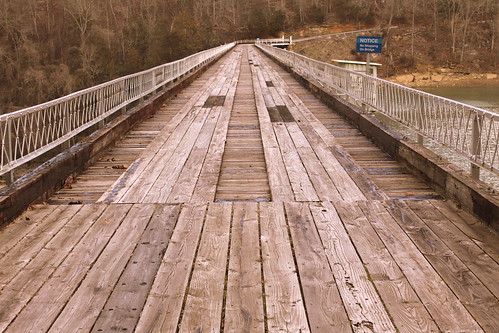This post card from 1969 shows a portion on the Rock Island Resort near the Great Falls Dam. Of particular interest is the Collins River Bridge in the background.

The largest truss on this bridge was originally erected in 1887-1889 as part of the Hyde’s Ferry Bridge located in Davidson County. Eugene Falconnet designed the bridge, and the Mount Vernon Bridge Company erected it. In 1917 Davidson County awarded a contract to the Nashville Bridge Company to relocate two spans from the Hyde’s Ferry Bridge and gave this span to the Nashville Bridge Company. The Nashville Bridge Company stored it until 1924 when the company erected it at this site. Arthur Dyer, president of the Nashville Bridge Company, often used this bridge as an example of the superiority of truss bridges over concrete due to their mobility.
This bridge is located near the 1916 Great Falls Dam, a major power source in the area. In 1922, That dam was raised 35 feet and the bridge which had been located here had to be replaced to accomidate the higher water level. Consequently, the Nashville Bridge Company removed the existing truss bridge from this site in 1924 and erected a new bridge using the stored truss from the Hydes Ferry Bridge.
TVA maintained responsibility for this bridge from the 1930s when they took over the nearby dam until 1982 when the road became state highway TN287. In 1986, a new two-lane bridge was completed parallel to this one and TDOT converted this one into a pedestrian bridge. From there, ownership was transferred to the TN Department of Conservation so that the bridge would be part of a nature trail at Rock Island State Park. Today, the bridge is off limits as both sides are fenced off and the park is hoping to someday raise funds to refurbish the historic bridge for future pedestrian use.
Technical details of the bridge are found in the book "Tennessee's Survey Report for Historic Highway Bridges" where this is entry #112: "Top chords and end posts are channels with lacing, and diagonals and the bottom chords are paired rectilinear eyebars. Verticals are channels with lacing except hip verticals which are paired rectilinear eyerods. Counters are single rectilinear tie rods. The bottom chords are below the floor beams, a somewhat unusual arrangement. The other spans are a 200-foot pin-connected Parker through truss, two 75-foot riveted Warren pony trusses, and three 20-foot steel I-beam approaches. The bridge has a curb-to-curb width of 15 feet and an out-to-out width of 17 feet. The substructure is concrete. Composition of the members of the 1924 trusses is typical. The Parker’s top chords and end posts are channels with lacing. Bottom chords, diagonals and counters are angles with battens. Verticals are paired angles with lacing. The Warrens’ top chords are channels, and the end posts are channels with battens. Bottom chords, verticals, and diagonals are angles with battens."




